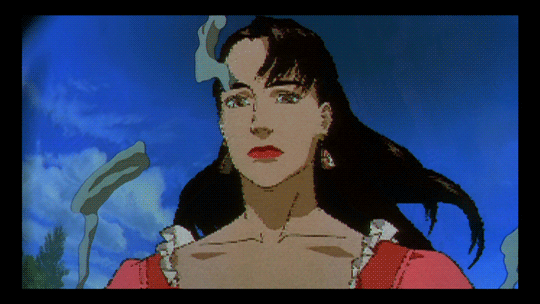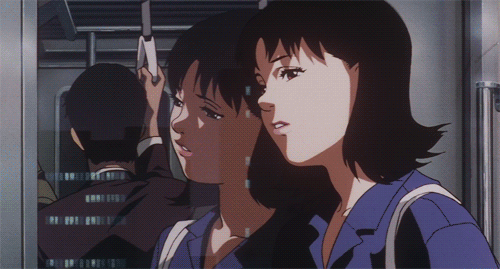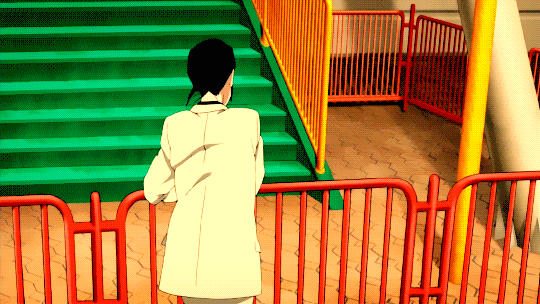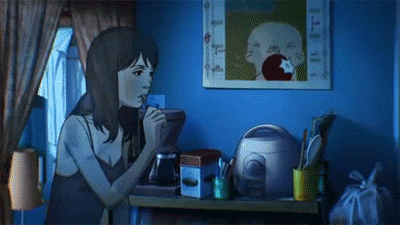originally posted at https://canmom.tumblr.com/post/627608...
It’s a Thursday, which means it’s time to make the pixels dance. Tonight my plan is to watch a couple of films by the legendary Satoshi Kon. Who looked like this:

I could possibly leave it there, because Satoshi Kon is one of the best known anime directors after Miyazaki! But let’s look back at some of the stuff he did.
Kon is renowned for the four films he directed in the late 90s and 2000s at Madhouse, but he started out following the traditional path into animation, drawing manga in school and university and working as an assistant to Katsuhiro Otomo (!), writing the script to one of Otomo’s two live action films. He started working on animation in the early 90s on a now somewhat forgotten film called Roujin Z, and then worked as a layout artist on Mamoru Oshii’s renowned Patlabor 2.
A little later, he ended up doing a lot of work on the short film Magnetic Rose in the Memories anthology, writing the script and designing layouts and backgrounds. So we can add Koji Morimoto to the list of big names he worked with!

Kon got started directing his own films in the 90s, starting with an episode of the JoJo OVA. But his first big film was Perfect Blue (1997), a rather harrowing film about an idol who is aggressively stalked by a fan. Perfect Blue established Kon’s style: extremely realistic, fluid and lavish animation, incredibly creative editing (as Every Frame A Painting described so well), and then blending the realistic animation with fantasy in a way only animation can.

When we speak of making full use of the animation medium vs live action, we often talk about animating impossible things, shapes blending in unphysical ways, geometric patterns and compositions… but while there’s definitely many weird sequences in Kon’s films, a lot of it is more subtle, about using the clarity of animation to speed up editing and more precisely control composition.
Of course, Kon could never pull this off without Madhouse’s really exceptional animators. It’s worth checking Sakugabooru’s database to see a few of their individual contributions!
Following the success of Perfect Blue, Kon hoped to adapt the novel Paprika, but this would have to wait. Instead, his second film ended up being Millennium Actress (2001), about a film actress on her deathbed who had hoped to return a key entrusted to her by a war dissenter, being interviewed by a film crew. This allows Kon to blend her story with the various genres in the history of Japanese film, from samurai period dramas to kaiju films.

This is one of the films I’m planning to watch tonight, and I haven’t yet seen it, so I won’t spoil where it goes! But judging by some of the clips I’ve seen, I honestly can’t wait. It also marks Kon’s first collaboration with composer Susumu Hirasawa.
Kon followed up Millennium Actress pretty rapidly, with Tokyo Godfathers (2003). While Kon’s other films show a reality blurring into dreams, films and hallucinations, Tokyo Godfathers takes a somewhat different angle, focusing on a tiny group of homeless people (including one of anime’s few depictions of a trans woman as anything other than a sight gag) who unexpectedly find themselves looking after a baby. I watched this film years ago, and I’d like to see it again, but I’m holding off until I can watch it on my own just because I’m not sure how they handle the trans bit, you know?

Tokyo Godfathers is less about blending into subjective perceptions of reality; instead it’s a chaotic story which unfolds through a series of improbable coincidences, revealing the character and aspirations of these three people as the situation cascades through society. I think the mob get involved. It’s been a while.
The next year, Kon took a brief break from films to direct his only TV anime, Paranoia Agent (2004). Paranoia Agent carries over a lot of the look of his films: tightly plotted, unusually realism-oriented drawing, extremely creative on the animation side. The story takes a number of twists, but at the outset it presents itself as a series of portraits of characters who are falling apart under the pressures of modern life, all of them who escape from their problems through an encounter mysterious ‘shounen bat’ who skates around hitting people with bats. Of course, it soon comes into question whether shounen bat is even real, and then before long, things get really weird. Everything actually revolves around a plush toy called Maromi, you see…

I don’t really know of any other TV anime that resembles Paranoia Agent, and it’s kind of hard to do it justice in one paragraph. Rather than try to pull out something representative, I’m planning (by request) to watch one of the more standalone episodes, Happy Family Planning. This is a startlingly upbeat story about three online strangers who meet up on the basis of a suicide pact. It goes places from there!
Then, finally, in 2006 Kon directed his most famous film, Paprika.

Without saying this lightly, Paprika is one of the most beautiful animated films that I’ve ever seen. If the animation budget on Madhouse’s other great 2006 film, The Girl Who Leapt Through Time, seemed kind of limited at times (despite the character animation skill on display), it was presumably because they were spending all their time drawing incredibly lavish carnival scenes. But hold on, what’s this actually about?
Paprika starts out with some astonishing chase sequences of a laughing, red-haired girl moving through scenes in improbable ways to evade her pursuers. We slowly realise that the plot hinges on a stolen machine designed to let people move in and out of each others’ dreams, which has inadvertently led to a kind of mental virus of a dream about a parade which starts spreading from person to person causing bizarre suicide attempts. The girl, it seems, is actually one of the researchers who invented the machine, secretly trying to use it for therapeutic purposes. But before long, the line between dream and reality starts, as you’d expect for Satoshi Kon, to break down completely.
Of course, it’s all a metaphor innit. Life under capitalism, etc. etc. I am going to have to see the film again before I can tell you what I think the metaphor is saying though :p

Paprika’s actual plot is a little notoriously hard to follow, but really who cares when you get to see this kind of animation? I do need to warn for some sexual assault threat/imagery towards the end of the film, I’ll make sure to mention that while we’re watching.
Paprika’s soundtrack is definitely worth a mention. To capture the uncanny atmosphere of the parade in particular, Susumu Hirasawa used vocaloid in an unusual way to create a tune that’s almost unfairly infectious. It sounds great, though.
Kon did a few smaller projects as well. I’m going to play his one-minute short Ohayo from the collection Ani*Kuri 15, and a music video he made based on the manga Berserk (turns out he was a fan!).

Tragically, Paprika ended up Satoshi Kon’s final film. Though Kon started working with Madhouse on a fifth film titled Dreaming Machine, and got as far as completing storyboards and beginning key animation, but in 2010 he was diagnosed with pancreatic cancer and withdrew from animation to spend his last half a year at home with his family. Kon died on August 24, 2010, almost exactly 10 years ago. Madhouse continued to work on Dreaming Machine for some time, but production stalled for financial reasons, and because Madhouse head Masao Maruyama did not feel any director could match Kon’s ability.
So, what’s the plan tonight? I’m going to show two of Kon’s films, Paprika and Millennium Actress, plus the aforementioned Happy Family Planning episode of Paranoia Agent, and Kon’s shorter works. On some future Animation Night, we’ll watch Kon’s other two films, once I’ve had time to pre-screen them and prepare suitable content warnings.
The time will be 7pm UK time, circa 5 hours from this post. The place will be twitch.tv/canmom! Hope to see you there, because these are some incredible films!
Comments